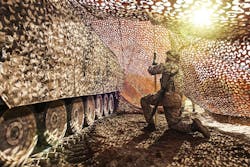Army looking for camouflage to shield moving military vehicles from enemy electro-optical sensors and radar
NATICK, Mass. – U.S. Army battlefield camouflage experts are approaching industry for ways to shield military combat vehicles while on the move from enemy infrared sensors and radar.
Officials of the Army Contracting Command at the Army Natick Soldier Systems Center in Natick, Mass., issued a request for project proposal (W911QY-20-S-0020) on Monday for the Mobile Camouflage System for Multiple Platforms project.
Mobile camouflage is necessary for combat vehicles in offensive and defensive operations, Army researchers say. Experts particularly are interest in camouflage that shields Army vehicles from near-infrared, shortwave infrared, medium-wave infrared, and long-wave heat-seeking sensors, as well as from RF and microwave radar waves.
Such static and mobile camouflage that is impervious to electro-optical and RF sensors, is necessary to provide decisive and superior protection for vehicles in battle positions and stationary environments.
In addition, Army experts say they need camouflage to protect vehicles against enemy multispectral sensors that can detect a variety of electromagnetic signatures, with an increased focus on high-heat and high-friction areas like exhaust, hubs, engine heat, and wheels.
Of particular interest is reducing vehicle identification by disrupting its shape and profile, and increasing its ability to blend with background vegetation.
U.S. Military forces operate in all environments and terrains throughout the world, researchers explain. Each theater produces unique challenges for protecting troops and vehicles from adversarial detection.
Ground combat vehicles need additional signature management. Beyond paint, today's methods of protecting combat vehicles on the move, or in hasty halt positions, include affixing organic material like freshly cut branches, or scraps of Ultra-Lightweight Camouflage Net System (ULCANS) netting to the top and sides of the vehicles.
Related: Quantum Imaging to provide infrared electro-optics for multispectral targeting systems
These methods, however, provide only limited, if any, visual signature suppression, and represent even less suppression performance throughout the electromagnetic spectrum.
Although ULCANS Increment I netting, being fielded now, provides Army vehicles in stationary positions with some signature suppression, there is a capability gap for vehicles and equipment that are on the move, or in a hasty halt position.
Instead, the Army needs new kinds of signature-suppressing camouflage that could be used together with existing camouflage to provide the best concealment in many operational situations.
The project will involve two phases over one year: first, provide component-level-size panel samples for affixing to vehicles; and a full-scale vehicle-size prototype for field testing. Several companies may be involved.
Companies interested should email three-page responses no later than 8 Aug 2020 to [email protected], and to the Army's Richard Totten at [email protected]. Put Responding Organization and RPP Title in the email subject line.
Email questions or concerns to Richard Totten at [email protected]. More information is online at https://beta.sam.gov/opp/032bf1b8072b47c79413ac6d72488aaf/view.

John Keller | Editor-in-Chief
John Keller is the Editor-in-Chief, Military & Aerospace Electronics Magazine--provides extensive coverage and analysis of enabling electronics and optoelectronic technologies in military, space and commercial aviation applications. John has been a member of the Military & Aerospace Electronics staff since 1989 and chief editor since 1995.

